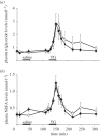Selective upregulation of lipid metabolism in skeletal muscle of foraging juvenile king penguins: an integrative study
- PMID: 22357259
- PMCID: PMC3350679
- DOI: 10.1098/rspb.2011.2664
Selective upregulation of lipid metabolism in skeletal muscle of foraging juvenile king penguins: an integrative study
Abstract
The passage from shore to marine life of juvenile penguins represents a major energetic challenge to fuel intense and prolonged demands for thermoregulation and locomotion. Some functional changes developed at this crucial step were investigated by comparing pre-fledging king penguins with sea-acclimatized (SA) juveniles (Aptenodytes patagonicus). Transcriptomic analysis of pectoralis muscle biopsies revealed that most genes encoding proteins involved in lipid transport or catabolism were upregulated, while genes involved in carbohydrate metabolism were mostly downregulated in SA birds. Determination of muscle enzymatic activities showed no changes in enzymes involved in the glycolytic pathway, but increased 3-hydroxyacyl-CoA dehydrogenase, an enzyme of the β-oxidation pathway. The respiratory rates of isolated muscle mitochondria were much higher with a substrate arising from lipid metabolism (palmitoyl-L-carnitine) in SA juveniles than in terrestrial controls, while no difference emerged with a substrate arising from carbohydrate metabolism (pyruvate). In vivo, perfusion of a lipid emulsion induced a fourfold larger thermogenic effect in SA than in control juveniles. The present integrative study shows that fuel selection towards lipid oxidation characterizes penguin acclimatization to marine life. Such acclimatization may involve thyroid hormones through their nuclear beta receptor and nuclear coactivators.
Figures



Similar articles
-
Lipid-induced thermogenesis is up-regulated by the first cold-water immersions in juvenile penguins.J Comp Physiol B. 2016 Jul;186(5):639-50. doi: 10.1007/s00360-016-0975-3. Epub 2016 Feb 29. J Comp Physiol B. 2016. PMID: 26924130
-
Skeletal muscle metabolism in sea-acclimatized king penguins. I. Thermogenic mechanisms.J Exp Biol. 2020 Nov 4;223(Pt 21):jeb233668. doi: 10.1242/jeb.233668. J Exp Biol. 2020. PMID: 32968000
-
Uncoupling effect of palmitate is exacerbated in skeletal muscle mitochondria of sea-acclimatized king penguins (Aptenodytes patagonicus).Comp Biochem Physiol A Mol Integr Physiol. 2017 Sep;211:56-60. doi: 10.1016/j.cbpa.2017.06.009. Epub 2017 Jun 17. Comp Biochem Physiol A Mol Integr Physiol. 2017. PMID: 28629794
-
Substrate cycling between de novo lipogenesis and lipid oxidation: a thermogenic mechanism against skeletal muscle lipotoxicity and glucolipotoxicity.Int J Obes Relat Metab Disord. 2004 Dec;28 Suppl 4:S29-37. doi: 10.1038/sj.ijo.0802861. Int J Obes Relat Metab Disord. 2004. PMID: 15592483 Review.
-
New insights concerning the role of carnitine in the regulation of fuel metabolism in skeletal muscle.J Physiol. 2007 Jun 1;581(Pt 2):431-44. doi: 10.1113/jphysiol.2006.125799. Epub 2007 Mar 1. J Physiol. 2007. PMID: 17331998 Free PMC article. Review.
Cited by
-
Lipid-induced thermogenesis is up-regulated by the first cold-water immersions in juvenile penguins.J Comp Physiol B. 2016 Jul;186(5):639-50. doi: 10.1007/s00360-016-0975-3. Epub 2016 Feb 29. J Comp Physiol B. 2016. PMID: 26924130
-
Non-lethal sampling for assessment of mitochondrial function does not affect metabolic rate and swimming performance.Philos Trans R Soc Lond B Biol Sci. 2024 Feb 26;379(1896):20220483. doi: 10.1098/rstb.2022.0483. Epub 2024 Jan 8. Philos Trans R Soc Lond B Biol Sci. 2024. PMID: 38186271 Free PMC article.
-
Transcriptomic data analysis and differential gene expression of antioxidant pathways in king penguin juveniles (Aptenodytes patagonicus) before and after acclimatization to marine life.Data Brief. 2016 Sep 22;9:549-555. doi: 10.1016/j.dib.2016.09.021. eCollection 2016 Dec. Data Brief. 2016. PMID: 27752524 Free PMC article.
References
-
- Ducharme M. B., Lounsbury D. S. 2007. Self-rescue swimming in cold water: the latest advice. Appl. Physiol. Nutr. Metab. 32, 799–80710.1139/H07-042 (doi:10.1139/H07-042) - DOI - DOI - PubMed
-
- Charrassin J., Bost C. 2001. Utilisation of the oceanic habitat by king penguins over the annual cycle. Mar. Ecol. Prog. Ser. 221, 285–29810.3354/meps221285 (doi:10.3354/meps221285) - DOI - DOI
-
- Pütz K. 2002. Spatial and temporal variability in the foraging areas of breeding king penguins. Condor 104, 528–53810.1650/0010-5422(2002)104[0528:SATVIT]2.0.CO;2 (doi:10.1650/0010-5422(2002)104[0528:SATVIT]2.0.CO;2) - DOI - DOI
-
- Cherel Y., Durant J. M., Lacroix A. 2004. Plasma thyroid hormone pattern in king penguin chicks: a semi-altricial bird with an extended posthatching developmental period. Gen. Comp. Endocrinol. 136, 398–40510.1016/j.ygcen.2004.02.003 (doi:10.1016/j.ygcen.2004.02.003) - DOI - DOI - PubMed
-
- Corbel H., Morlon F., Groscolas R. 2008. Is fledging in king penguin chicks related to changes in metabolic or endocrinal status? Gen. Comp. Endocrinol. 155, 804–81310.1016/j.ygcen.2007.11.006 (doi:10.1016/j.ygcen.2007.11.006) - DOI - DOI - PubMed
Publication types
MeSH terms
Substances
LinkOut - more resources
Full Text Sources
Molecular Biology Databases

